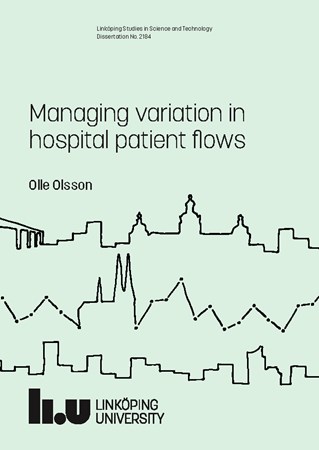Crowding-out
Olle Olsson.
In his doctoral thesis Managing variation in hospital patient flows, Olle Olsson studies whether standardised healthcare flows lead to crowding-out effects and longer waiting times for the patients with illnesses not included in the uniform healthcare model. The risk of such effects has been discussed for many years, but scientifically confirming their existence has been difficult.
Olle Olsson’s doctoral thesis shows, in a quantitative study, that crowding-out effects actually exist, and which patient groups they affect.
“The effect isn’t particularly big, but it’s clear. The patients who are affected most are the ones who are at the top of the ‘prioritise’ list, but are then bypassed by the patients in the standardised patient flows”, says Olle Olsson.
Several benefits
In standardised patient flows, all patients with a particular disease must be received and treated in the same way, regardless of who they are and which part of the country they live in. The model was originally introduced for cancer, but has subsequently been applied to other diseases. In general, with standardised patient flows, the patients they cover are prioritised higher than before.
“Also, it’s a more convenient method, and it delivers several other benefits for the healthcare system”, says Olle Olsson, adding that the crowding-out effects can, to a degree, be counteracted.
“It’s not easy. But if you’re aware of the problem and include it in the descriptions of the patient flow, you’re off to a good start. I also think it’s important to try to limit the allocation of patients into different priority groups, because average waiting times increase when there are more categories to deal with.”
Differencies
The doctoral thesis consists of three studies which were conducted at hospitals in Hässleholm, Linköping and Kalmar, where Olle Olsson now works as business developer. In the first study he compares how changes in patient flows affect bed occupancy rates and treatment times at emergency departments and inpatient wards.
The emergency wards are affected least, which indicates that they are more flexible and can more easily adapt their operations to patient volumes.
“It might depend on differences in staffing. At an emergency department there are often more staff when it’s known that lots of patients normally come in, such as after weekends and holidays, but at an inpatient ward, staff are more evenly distributed.”
Decentralisation
In the second study, Olle Olsson shows that measures for managing emergency patient flows are more often made at the clinical level than at the hospital level. This is due to the decentralisation in healthcare, which can have many advantages, but can increase the risk of sub-optimisation. As a result, measures at one level can have unwanted consequences at another.
Perhaps the most important conclusion of the research is the need for big-picture perspectives and systematic approaches. The fundamental problem is easy to formulate but difficult to solve: how should healthcare allocate and prioritise all the patients with varying needs and illnesses.
“That's a general lesson from my three studies”, says Olle Olsson, suggesting some possible solutions:
“I don’t think that more centralised management will help. Developments in healthcare will require decentralisation, and whichever organisation you choose, there will be challenges. However there is a need for plans, methods and support from higher up in order to manage these problems.”
